Yongkang Wu
RetroLLM: Empowering Large Language Models to Retrieve Fine-grained Evidence within Generation
Dec 16, 2024



Abstract:Large language models (LLMs) exhibit remarkable generative capabilities but often suffer from hallucinations. Retrieval-augmented generation (RAG) offers an effective solution by incorporating external knowledge, but existing methods still face several limitations: additional deployment costs of separate retrievers, redundant input tokens from retrieved text chunks, and the lack of joint optimization of retrieval and generation. To address these issues, we propose \textbf{RetroLLM}, a unified framework that integrates retrieval and generation into a single, cohesive process, enabling LLMs to directly generate fine-grained evidence from the corpus with constrained decoding. Moreover, to mitigate false pruning in the process of constrained evidence generation, we introduce (1) hierarchical FM-Index constraints, which generate corpus-constrained clues to identify a subset of relevant documents before evidence generation, reducing irrelevant decoding space; and (2) a forward-looking constrained decoding strategy, which considers the relevance of future sequences to improve evidence accuracy. Extensive experiments on five open-domain QA datasets demonstrate RetroLLM's superior performance across both in-domain and out-of-domain tasks. The code is available at \url{https://github.com/sunnynexus/RetroLLM}.
CORAL: Benchmarking Multi-turn Conversational Retrieval-Augmentation Generation
Oct 30, 2024



Abstract:Retrieval-Augmented Generation (RAG) has become a powerful paradigm for enhancing large language models (LLMs) through external knowledge retrieval. Despite its widespread attention, existing academic research predominantly focuses on single-turn RAG, leaving a significant gap in addressing the complexities of multi-turn conversations found in real-world applications. To bridge this gap, we introduce CORAL, a large-scale benchmark designed to assess RAG systems in realistic multi-turn conversational settings. CORAL includes diverse information-seeking conversations automatically derived from Wikipedia and tackles key challenges such as open-domain coverage, knowledge intensity, free-form responses, and topic shifts. It supports three core tasks of conversational RAG: passage retrieval, response generation, and citation labeling. We propose a unified framework to standardize various conversational RAG methods and conduct a comprehensive evaluation of these methods on CORAL, demonstrating substantial opportunities for improving existing approaches.
IAG: Induction-Augmented Generation Framework for Answering Reasoning Questions
Nov 30, 2023Abstract:Retrieval-Augmented Generation (RAG), by incorporating external knowledge with parametric memory of language models, has become the state-of-the-art architecture for open-domain QA tasks. However, common knowledge bases are inherently constrained by limited coverage and noisy information, making retrieval-based approaches inadequate to answer implicit reasoning questions. In this paper, we propose an Induction-Augmented Generation (IAG) framework that utilizes inductive knowledge along with the retrieved documents for implicit reasoning. We leverage large language models (LLMs) for deriving such knowledge via a novel prompting method based on inductive reasoning patterns. On top of this, we implement two versions of IAG named IAG-GPT and IAG-Student, respectively. IAG-GPT directly utilizes the knowledge generated by GPT-3 for answer prediction, while IAG-Student gets rid of dependencies on GPT service at inference time by incorporating a student inductor model. The inductor is firstly trained via knowledge distillation and further optimized by back-propagating the generator feedback via differentiable beam scores. Experimental results show that IAG outperforms RAG baselines as well as ChatGPT on two Open-Domain QA tasks. Notably, our best models have won the first place in the official leaderboards of CSQA2.0 (since Nov 1, 2022) and StrategyQA (since Jan 8, 2023).
Zero-Shot Continuous Prompt Transfer: Generalizing Task Semantics Across Language Models
Oct 02, 2023



Abstract:Prompt tuning in natural language processing (NLP) has become an increasingly popular method for adapting large language models to specific tasks. However, the transferability of these prompts, especially continuous prompts, between different models remains a challenge. In this work, we propose a zero-shot continuous prompt transfer method, where source prompts are encoded into relative space and the corresponding target prompts are searched for transferring to target models. Experimental results confirm the effectiveness of our method, showing that 'task semantics' in continuous prompts can be generalized across various language models. Moreover, we find that combining 'task semantics' from multiple source models can further enhance the generalizability of transfer.
Unsupervised Chunking with Hierarchical RNN
Sep 10, 2023



Abstract:In Natural Language Processing (NLP), predicting linguistic structures, such as parsing and chunking, has mostly relied on manual annotations of syntactic structures. This paper introduces an unsupervised approach to chunking, a syntactic task that involves grouping words in a non-hierarchical manner. We present a two-layer Hierarchical Recurrent Neural Network (HRNN) designed to model word-to-chunk and chunk-to-sentence compositions. Our approach involves a two-stage training process: pretraining with an unsupervised parser and finetuning on downstream NLP tasks. Experiments on the CoNLL-2000 dataset reveal a notable improvement over existing unsupervised methods, enhancing phrase F1 score by up to 6 percentage points. Further, finetuning with downstream tasks results in an additional performance improvement. Interestingly, we observe that the emergence of the chunking structure is transient during the neural model's downstream-task training. This study contributes to the advancement of unsupervised syntactic structure discovery and opens avenues for further research in linguistic theory.
Pre-training for Information Retrieval: Are Hyperlinks Fully Explored?
Sep 14, 2022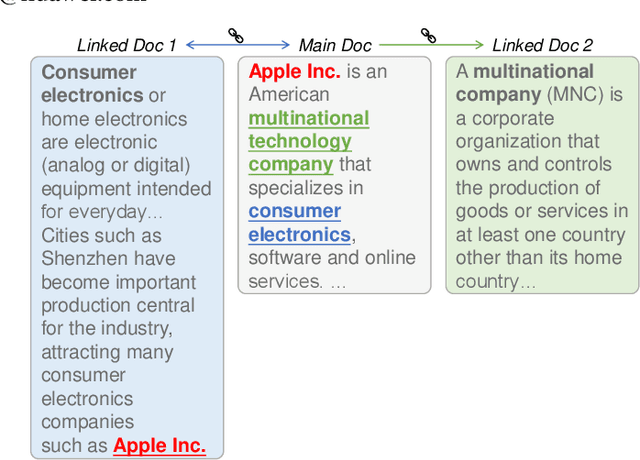
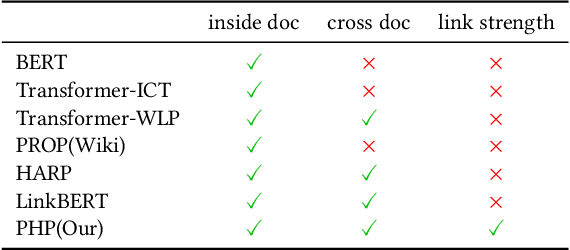
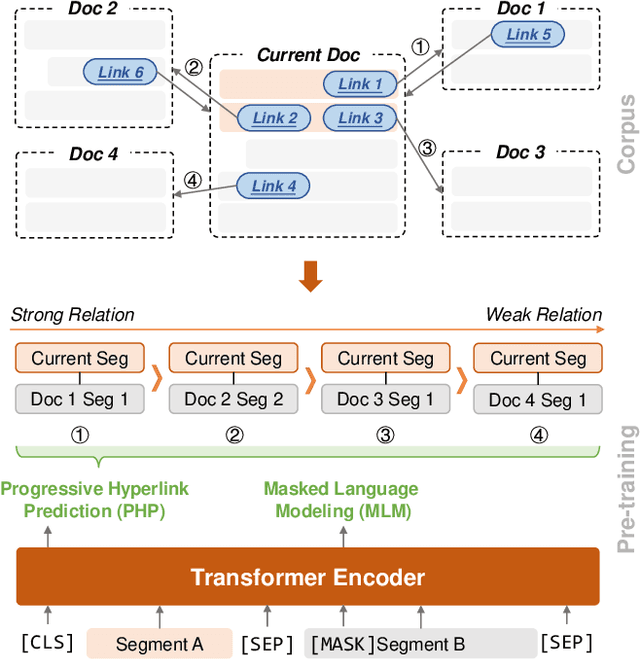
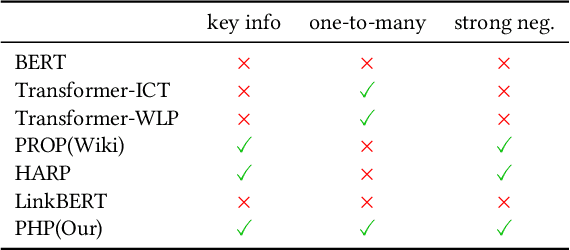
Abstract:Recent years have witnessed great progress on applying pre-trained language models, e.g., BERT, to information retrieval (IR) tasks. Hyperlinks, which are commonly used in Web pages, have been leveraged for designing pre-training objectives. For example, anchor texts of the hyperlinks have been used for simulating queries, thus constructing tremendous query-document pairs for pre-training. However, as a bridge across two web pages, the potential of hyperlinks has not been fully explored. In this work, we focus on modeling the relationship between two documents that are connected by hyperlinks and designing a new pre-training objective for ad-hoc retrieval. Specifically, we categorize the relationships between documents into four groups: no link, unidirectional link, symmetric link, and the most relevant symmetric link. By comparing two documents sampled from adjacent groups, the model can gradually improve its capability of capturing matching signals. We propose a progressive hyperlink predication ({PHP}) framework to explore the utilization of hyperlinks in pre-training. Experimental results on two large-scale ad-hoc retrieval datasets and six question-answering datasets demonstrate its superiority over existing pre-training methods.
Coarse-to-Fine: Hierarchical Multi-task Learning for Natural Language Understanding
Aug 19, 2022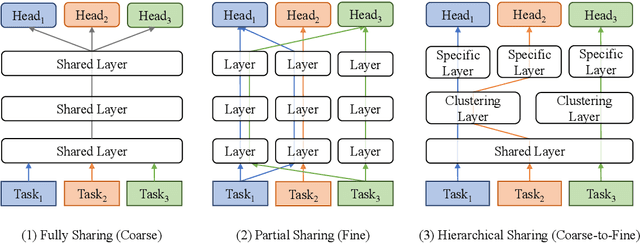
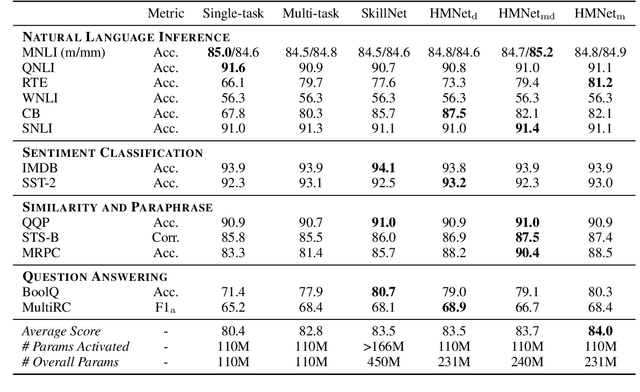


Abstract:Generalized text representations are the foundation of many natural language understanding tasks. To fully utilize the different corpus, it is inevitable that models need to understand the relevance among them. However, many methods ignore the relevance and adopt a single-channel model (a coarse paradigm) directly for all tasks, which lacks enough rationality and interpretation. In addition, some existing works learn downstream tasks by stitches skill block(a fine paradigm), which might cause irrationalresults due to its redundancy and noise. Inthis work, we first analyze the task correlation through three different perspectives, i.e., data property, manual design, and model-based relevance, based on which the similar tasks are grouped together. Then, we propose a hierarchical framework with a coarse-to-fine paradigm, with the bottom level shared to all the tasks, the mid-level divided to different groups, and the top-level assigned to each of the tasks. This allows our model to learn basic language properties from all tasks, boost performance on relevant tasks, and reduce the negative impact from irrelevant tasks. Our experiments on 13 benchmark datasets across five natural language understanding tasks demonstrate the superiority of our method.
Towards More Effective and Economic Sparsely-Activated Model
Oct 14, 2021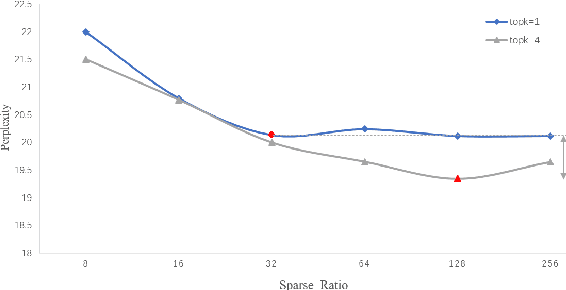

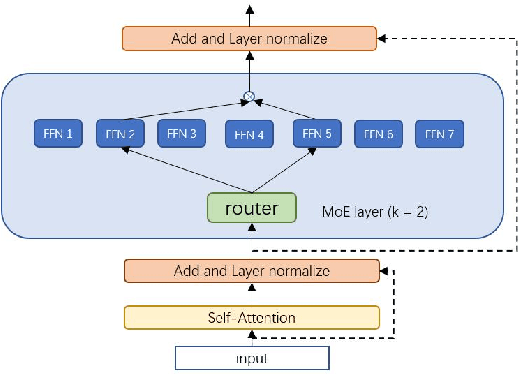
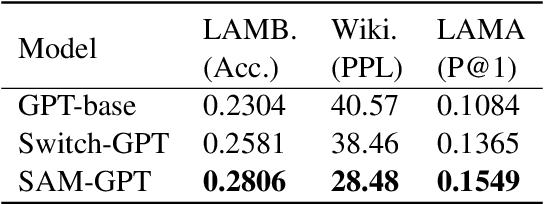
Abstract:The sparsely-activated models have achieved great success in natural language processing through large-scale parameters and relatively low computational cost, and gradually become a feasible technique for training and implementing extremely large models. Due to the limit of communication cost, activating multiple experts is hardly affordable during training and inference. Therefore, previous work usually activate just one expert at a time to alleviate additional communication cost. Such routing mechanism limits the upper bound of model performance. In this paper, we first investigate a phenomenon that increasing the number of activated experts can boost the model performance with higher sparse ratio. To increase the number of activated experts without an increase in computational cost, we propose SAM (Switch and Mixture) routing, an efficient hierarchical routing mechanism that activates multiple experts in a same device (GPU). Our methods shed light on the training of extremely large sparse models and experiments prove that our models can achieve significant performance gain with great efficiency improvement.
YES SIR!Optimizing Semantic Space of Negatives with Self-Involvement Ranker
Sep 14, 2021



Abstract:Pre-trained model such as BERT has been proved to be an effective tool for dealing with Information Retrieval (IR) problems. Due to its inspiring performance, it has been widely used to tackle with real-world IR problems such as document ranking. Recently, researchers have found that selecting "hard" rather than "random" negative samples would be beneficial for fine-tuning pre-trained models on ranking tasks. However, it remains elusive how to leverage hard negative samples in a principled way. To address the aforementioned issues, we propose a fine-tuning strategy for document ranking, namely Self-Involvement Ranker (SIR), to dynamically select hard negative samples to construct high-quality semantic space for training a high-quality ranking model. Specifically, SIR consists of sequential compressors implemented with pre-trained models. Front compressor selects hard negative samples for rear compressor. Moreover, SIR leverages supervisory signal to adaptively adjust semantic space of negative samples. Finally, supervisory signal in rear compressor is computed based on condition probability and thus can control sample dynamic and further enhance the model performance. SIR is a lightweight and general framework for pre-trained models, which simplifies the ranking process in industry practice. We test our proposed solution on MS MARCO with document ranking setting, and the results show that SIR can significantly improve the ranking performance of various pre-trained models. Moreover, our method became the new SOTA model anonymously on MS MARCO Document ranking leaderboard in May 2021.
 Add to Chrome
Add to Chrome Add to Firefox
Add to Firefox Add to Edge
Add to Edge